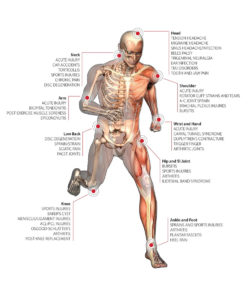 “Half of all ankle sprains occur during athletic activity” according to Waterman, Owens et al in Journal of Bone & Joint Surgery Am, 2010 Oct 06.
“Half of all ankle sprains occur during athletic activity” according to Waterman, Owens et al in Journal of Bone & Joint Surgery Am, 2010 Oct 06.
In addition, the article states “Ankle sprain is the most common injury in athletic populations, accounting for up to 30% of sports injuries.” Pain, swelling, stiffness and even bruising occur depending on the grade of the ankle sprain.
Traditional Treatments
Typical protocols for Grades 1, 2 and 3 ankle sprains call for rest, ice, compression and elevation (RICE). And recent updates of this conventional prescription include PRICE (Protect, RICE) and POLICE (Protect, Optimal Loading, ICE).
There’s no consistent evidence that either of these approaches is optimal for all sprains, but there is a consensus that reducing swelling and pain, and restoring function and motion as quickly as possible without further injury to the tissue is critical to effective recovery.
Acute Injury – Time is of the Essence
The better-known RICE and PRICE approaches both often requires the injured patient to stay off the ankle until the inflammation decreases. Meanwhile, the range of motion is compromised. The POLICE approach emphasizes the importance of early mobilization.
Laser Treatment – The New Way Forward
Applying a laser as quickly as possible will bring optimal results. Treating the ankle, twice a day for the first several days will:
- reduce inflammation,
- decrease pain,
- improve range of motion and
- begin the healing of the ligaments.
Of course, ice and compression may be utilized concurrently, according to the severity and specific symptoms of the injury.
K-Laser Therapy
Class IV K-Lasers provide certain red and near-infrared wavelengths of laser light proven to help the body manage pain and inflammation while speeding up tissue regeneration.
If you’re looking for a solution without drugs and surgery, ask your foot specialist about K-Laser!
It helps reduce: Inflammation, swelling, muscle spasm, stiffness, and pain.




